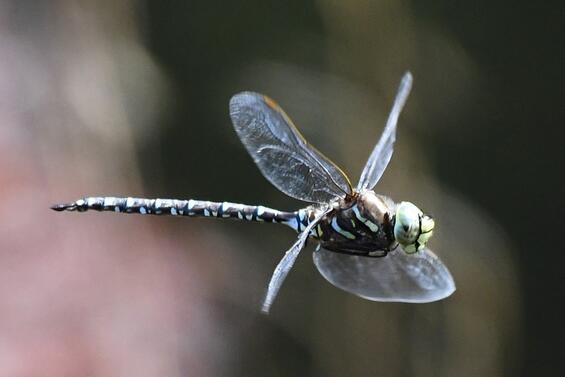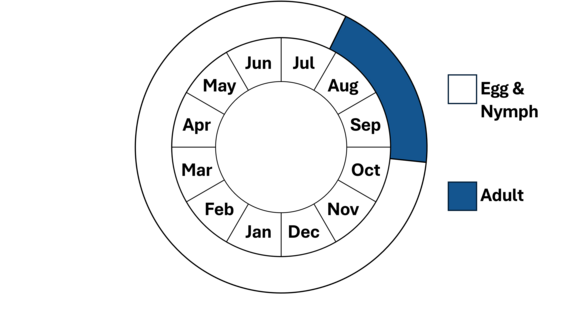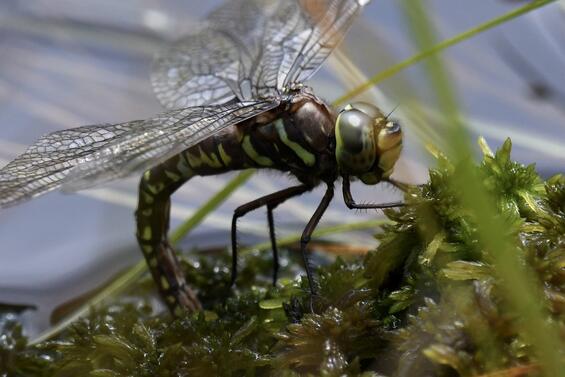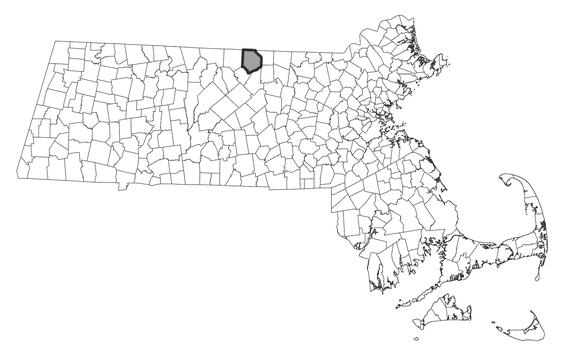- Scientific name: Aeshna subarctica
- Species of Greatest Conservation Need (MA State Wildlife Action Plan)
- Endangered (MA Endangered Species Act)
Description

Male subarctic darner
The subarctic darner is an insect species in the order Odonata, suborder Anisoptera (the dragonflies), and family Aeshnidae (the Darners). The adult is a large dragonfly magnificently colored with greens, blues, and rich browns. The thorax (winged and legged segment behind the head) is mostly brown, with two blue-green dorsal stripes and two blue-green to yellowish lateral stripes. The abdominal segments are predominantly brown with green to blue markings. The subarctic darner has brown to black legs and transparent to amber-tinged wings. The face is yellow with a thin black cross-line, and the eyes are dull blue-gray to green in color.
Subarctic darners range from 66-76 mm (2.6 to almost 3 in) in overall length, with the females averaging somewhat larger. Wingspread ranges from 78-92 mm (3.1 to 3.6 in). The nymphs are relatively long and slender, averaging about 36 mm (1.4 in) in length when fully grown.
Nine species of mosaic darners (genus Aeshna) occur in Massachusetts and the subarctic darner closely resembles many of them in appearance. For adult identification, the slight differences in pattern and coloration on the thorax and face can distinguish the various species. The anterior lateral thoracic stripe narrows to a shallow bent in the middle and has a relatively thin dorsal flag above (Lam 2024). The two primary thoracic stripes are blue-green above and yellow below. Thinner and shorter stripes exist between and anterior to the two primary thoracic stripes (Paulson 2012). In addition, the face of the subarctic darner is yellow with a black cross-line. The Canada darner, green-striped darner, and lance-tipped darner are similar in appearance, but lack the black cross-line on the face and the markings on the thorax and abdomen differ in shape and coloration (Nikula et al. 2007). The subarctic darner is unlikely to be encountered outside of northern Massachusetts.
Nymphs and exuviae can be distinguished from other Aeshna using nymph identification keys (e.g., Tennessen 2019) and a dissecting scope.
Life cycle and behavior

Note nymph stage occurs year-round.
The egg and nymph stages of the subarctic darner are aquatic that develop in soupy sphagnum pools in bogs and deep fens. The amount of time required for the development of the eggs and nymphs is uncertain. The eggs may hatch within a month or overwinter, but the nymph may take as long as 3-4 years to reach maturity. As a nymph grows, it sheds its skin, or exoskeleton, at the end of each stage of growth or instar. At the last instar, the nymph emerges from the water and transforms into an adult leaving behind its nymphal exoskeleton, known as an exuvia, on their emerging substrate (e.g., emergent vegetation).
The immature adult dragonflies spend several days or more feeding and maturing in upland areas away from water, often some distance from the breeding site. Subarctic darners, like other darners, feed on other aerial insects, which they capture on the wing. They are active through dusk. When at rest, they hang from vegetation in a vertical position, often high in the trees.
Males patrol the breeding site, flying over wetter areas of bogs and fens. When more than one male is present, aggressive interactions are frequent and often end with one male chasing another high over the tree-tops out of sight.
Female subarctic darners appear at the breeding sites when ready to breed. The male uses its claspers at the tip the abdomen to grab the female behind the eyes. If the female is receptive, she curls her abdomen upward to couple with the male on the underside of his second abdominal segment. Once successfully coupled, the pair flies off high into the nearby woodland to mate. Male dragonflies will mate with as many females as possible; the females may also mate with more than one male. Subarctic darner females oviposit (lay eggs) in mosses and sedges at the edges of pools. The number of eggs laid by an individual female subarctic darner is not known, but in many dragonfly species often numbers into the hundreds.
Adult subarctic darners typically first appear in late July and actively fly until early October.

Female Subarctic Darner ovipositing into moss at water’s edge.
Population status
The subarctic darner is a rare member of its genus in eastern North America, and is an endangered species in Massachusetts. Breeding has been documented at one of two known documented sites for this species. Recent efforts have failed to redocument this species at known wetlands since the early 2000’s. As with all species listed in Massachusetts, individuals of the species are protected from take (picking, collecting, killing, etc.) and sale under the Massachusetts Endangered Species Act.
Distribution and abundance
The subarctic darner is a circumboreal species whose range extends across much of northern Europe, across into Japan, and through Canada. It dips down into New England, with northern Massachusetts and central New York at the southern edge of its range in this region. In Massachusetts, it’s known from only two sites in the north-central part of the state, both in Ashburnham.

Distribution in Massachusetts.
1999-2024
Based on records in the Natural Heritage Database.
Habitat
The subarctic darner can be found in sphagnum bogs and deep fens with open pools. The nymphs are aquatic, living in soupy sphagnum pools and among aquatic vegetation. The adults inhabit wooded uplands and clearings.
Healthy habitats are vital for supporting native wildlife and plants. Explore habitats and learn about conservation and restoration in Massachusetts.
Northern Massachusetts bog habitat typical for subarctic darner.
Threats
The greatest threat to this species is loss and degradation of wetlands from development and the impacts of pollution resulting from road run-off. Additional threats include loss of upland forests needed for adult development and water-level manipulation from beavers and humans. Climate change poses a potential threat for subarctic darner persistence in Massachusetts as its southern range limit is in Massachusetts.
Conservation
Survey and monitoring
Surveys should target known sites and new wetlands to determine subarctic darner occupancy. Although the subarctic darner has been detected from only two sites, the species has the potential to occupy other bogs and fens in northern Massachusetts. Surveys should target adults in feeding and breeding habitats, where the species is mostly likely to be detected. Multiple site visits (e.g., >3) are likely required to detect this species because of its rarity and its propensity to avoid capture by net or camera. Known sites should be monitored every 5 years when practical to document changes in occupancy and habitat conditions.
Management
Land and wetland protection is critical for the conservation of subarctic darner. Upland habitats adjoining the breeding sites should be maintained for roosting, hunting, and for newly emerged adults that are more susceptible to mortality from predation and inclement weather. Management of beaver-induced water levels may be needed to minimize bog and fen habitat degradation.
Research needs
The effects of climate change on subarctic darner and climate resistance of its aquatic-nymphal habitat, including water temperature, water quantity, and associated chemistry interactions are uncertain and warrant further investigation. Furthermore, confirmation of known and identification of new source and sink wetlands are needed to accurately assess the species risk to anthropogenic threats.
References
Dunkle, Sidney W. Dragonflies Through Binoculars. Oxford University Press, 2000.
Lam, E. Dragonflies of North America. Princeton NJ: Princeton University Press, 2024.
Needham, J.G., M.J. Westfall, Jr., and M.L. May. Dragonflies of North America. Scientific Publishers, 2000.
Nikula, B., J.L. Ryan, and M.R. Burne. A Field Guide to the Dragonflies and Damselflies of Massachusetts. 2nd ed. Massachusetts Natural Heritage and Endangered Species Program, 2007.
Paulson, D. Dragonflies and Damselflies of the East. Princeton NJ: Princeton University Press, 2011.
Soltesz, K. Identification Keys to Northeastern Anisoptera Larvae. Center for Conservation and Biodiversity, University of Connecticut, 1996.
Tennessen, K. Dragonfly Nymphs of North America: An identification guide. Springer, 2019.
Walker, E.M. 1958. The Odonata of Canada and Alaska, Vol. II. University of Toronto Press.
Contact
| Date published: | March 6, 2025 |
|---|